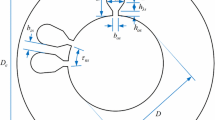Abstract
This paper presents a powerful application of genetic algorithm (GA) for the minimization of the total harmonic current distortion (THCD) in high-power induction motors fed by voltage source inverters, based on an approximate harmonic model. That is, having defined a desired fundamental output voltage, optimal pulse patterns (switching angles) are determined to produce the fundamental output voltage while minimizing the THCD. The complete results for the two cases of three and five switching instants in the first quarter period of pulse width modulation (PWM) waveform are presented. Presence of harmonics in the stator excitation leads to a pulsing-torque component. Considering the fact that if the pulsing-torques are at low frequencies, they can cause troublesome speed fluctuations, shaft fatigue, and unsatisfactory performance in the feedback control system, the 5th, 7th, 11th, and 13th current harmonics (in the case of five switching angles) are constrained at some pre-specified values, to mitigate the detrimental effects of low-frequency harmonics. At the same time, the THCD is optimized while the required fundamental output voltage is maintained.
Similar content being viewed by others
References
Asumadu, J.A., Hoft, R.G., 1989. Microprocessor-based sinusoidal waveform synthesis using Walsh and related orthogonal functions. IEEE Trans. on Power Electron., 4(2):234–241. [doi:10.1109/63.24908]
Bäck, T., Hammel, U., Schäutz, M., Schwefel, H.P., Sprave, J., 1996. Applications of Evolutionary Algorithms at the Center for Applied Systems Analysis. In: Desideri, J.A., Hirsch, C., le Tallec, P., et al. (Eds.), Computational Methods in Applied Sciences. Wiley, Chichester, UK, p.243–250.
Bäck, T., Hammel, U., Schwefel, H.P., 1997. Evolutionary computation: comments on the history and current state. IEEE Trans. on Evol. Comput., 1(1):3–17. [doi:10.1109/4235.585888]
Bose, B.K., 1986. Power Electronics and AC Drives. Prentice-Hall, NJ.
Chen, C., 1999. Linear Systems Theory and Design (3rd Ed.). Oxford University Press, London, UK.
Chiasson, J.N., Tolbert, L.M., McKenzie, K., Du, Z., 2002. Eliminating Harmonics in a Multilevel Converter Using Resultant Theory. IEEE Power Electronics Specialists Conf., Cairns, Australia, p.503–508.
Chiasson, J.N., Tolbert, L.M., McKenzie, K., Du, Z., 2004. A complete solution to the harmonic elimination problem. IEEE Trans. on Power Electron., 19(2):491–499. [doi:10.1109/TPEL.2003.823207]
Cox, D., Little, J., OShea, D., 1996. Ideals, Varieties, and Algorithms: An Introduction to Computational Algebraic Geometry and Commutative Algebra (2nd Ed.). Springer-Verlag, NY.
Davis, L., 1991. Handbook of Genetic Algorithms. van Nostrand Reinhold, New York.
Deb, K., 2001. Multi-objective Optimization Using Evolutionary Algorithms. Wiley, Chichester, UK.
Fitzgerald, A.E., Kingsley, C., Umans, S.D., 1985. Electric Machinery (4th Ed.). McGraw Hill, New York, NY.
Goldberg, D., 1989. Genetic Algorithms in Search, Optimization, and Machine Learning. Reading, Addison-Wesley, MA.
Hansen, E.R., 1975. A Table of Series and Products. Prentice-Hall, Englewood Cliffs, NJ.
Holtz, J., 1992. Pulsewidth modulation—a survey. IEEE Trans. on Ind. Electron., 39(5):410–420. [doi:10.1109/41.161472]
Kailath, T., 1980. Linear Systems. Englewood Cliffs, Prentice-Hall, NJ.
Kim, J.H., Myung, H., 1997. Evolutionary programming techniques for constrained optimization problems. IEEE Trans. on Evol. Comput., 1(2):129–140. [doi:10.1109/4235.687880]
Michalewicz, Z., Dasgupta, D., le Riche, R.G., Schoenauer, M., 1996. Evolutionary algorithms for constrained engineering problems. Comput. Ind. Eng. J., 30(4):851–870. [doi:10.1016/0360-8352(96)00037-X]
Mitchell, M., 1996. An Introduction to Genetic Algorithms (1st Ed.). Prentice-Hall, India.
Mohan, N., Undeland, T.M., Robbins, W.P., 1995. Power Electronics: Converters, Applications, and Design (2nd Ed.). Wiley, New York.
Murphy, J.M.D., Turnbull, F.G., 1988. Power Electronic Control of AC Motors. Pergamon Press, Oxford.
Ozpineci, B., Tolbert, L.M., Chiasson, J.N., 2005. Harmonic optimization of multilevel converters using genetic algorithms. IEEE Power Electron. Lett., 3(3):92–95. [doi:10.1109/LPEL.2005.856713]
Park, M.H., Ahn, D.S., Won, C.Y., Lee, H.K., Kim, T.H., 1990. Microprocessor-based new Harmonic Elimination Method Using Walsh-Fourier Transformation. Proc. Int. Power Electron. Conf., p.799–808.
Rezazadeh, A.R., Sayyah, A., Aflaki, M., 2006. Modulation Error Observation and Regulation for Use in On-line Optimal PWM Fed High Power Synchronous Motors. Proc. 1st IEEE Conf. on Industrial Electronics and Applications, Singapore, p.1300–1307.
Sathyanarayan, S.R., Birru, H.K., Chellapilla, K., 1999. Evolving Nonlinear Time-series Models Using Evolutionary Programming. Proc. Congress Evolutionary Computation, 1:236–243.
Sayyah, A., Aflaki, M., Rezazade, A.R., 2006a. Optimal PWM for Minimization of Total Harmonic Current Distortion in High-power Induction Motors Using Genetic Algorithms. Proc. IEEE Int. Conf. SICE-ICCAS, Busan, Korea, p.5494–5499.
Sayyah, A., Aflaki, M., Rezazade, A.R., 2006b. Optimization of THD and Suppressing Certain Order Harmonics in PWM Inverters Using Genetic Algorithms. Proc. IEEE Int. Symp. Intelligent control, Munich, Germany, p.874–879.
Schwefel, H.P., 1979. Direct Search for Optimal Parameters Within Simulation Models. Proc. 12th Annual Simulation Symp., Tampa, FL, p.91–102.
Sun, J., 1995. Optimal Pulse Width Modulation Techniques for High-power Voltage-source Inverters. PhD Thesis, VDI VERLAG, Däusseldorf.
Sun, J., Grotstollen, H., 1994. Pulse Width Modulation Based on Real-time Solution of Algebraic Harmonic Elimination Equations. Proc. 20th Int. Conf. on Industrial Electronics, Control and Instrumentation, 1:79–84.
Sun, J., Beineke, S., Grotstollen, H., 1996. Optimal PWM based on real-time solution of harmonic elimination equations. IEEE Trans. on Power Electron., 11(4):612–621. [doi:10.1109/63.506127]
Author information
Authors and Affiliations
Corresponding author
Rights and permissions
About this article
Cite this article
Sayyah, A., Aflaki, M. & Rezazadeh, A. Optimization of total harmonic current distortion and torque pulsation reduction in high-power induction motors using genetic algorithms. J. Zhejiang Univ. Sci. A 9, 1741–1752 (2008). https://doi.org/10.1631/jzus.A0820055
Received:
Accepted:
Published:
Issue Date:
DOI: https://doi.org/10.1631/jzus.A0820055
Key words
- Induction motor
- Genetic algorithm (GA)
- Optimization
- Pulse width modulation (PWM)
- Torque pulsation
- Total harmonic current distortion (THCD)




